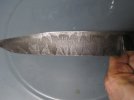- Joined
- Aug 27, 2004
- Messages
- 2,524
It is just blending of different steel to make a contrast of color/texture.
No, that is just a nice by product.
Today, it just looks cool and offers practically zero performance.
You don't get out much do you...........
I'm about to order a Damascus sujihiki and the Damascus is purely for looks.
Well, since I don't speak sujihiki, my only advice would be to make sure you order it from either Pakistan or China-ville. That way you will know you are getting the Top Shelf material. Ooops....... I forgot, you are apparently ordering it just for looks.
Enjoy looking at it.
Robert

